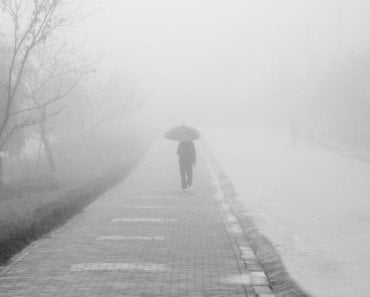The earthy scent produced when rain falls on dry soil is technically called petrichor. Petrichor is generally caused due to the secretion of oils by some plants, the generation of the geosmin chemical by Actinomycetes bacteria, ozone, and also our higher nasal sensitivity to the scent of petrichor.
Rain is one of the most beautiful gifts bestowed on us by nature. Almost everyone (except bats and foxes) love the rainy season—especially the first rain of the summer. The sight of raindrops falling after a long summer is truly beautiful. The only thing more pleasant is the ‘smell’ of that rain when it first hits the ground.
Yes, the smell that makes us go woozy and poetic and romantic. It seems to come from rain striking the dry ground. Many are familiar with this smell, but why is that distinctive smell of rain so wonderful? Water itself doesn’t have any smell, so what’s the secret behind this mesmerizing smell?
Let’s find out…
Recommended Video for you:
It’s Petrichor!
The earthy scent produced when rain falls on dry soil is technically called petrichor. The term “petrichor” was coined by Australian scientists who were researching the nature of argillaceous odor in 1964. They investigated the aroma coming from moist clay, sediment and rock. There were numerous other studies conducted later to figure out what causes petrichor and if we can artificially mimic it.
The petrichor scent is generally caused due to the secretion of oils by some plants, the generation of geosmin by Actinomycetes bacteria, the presence of ozone, and also our higher nasal sensitivity to the scent of petrichor. Let’s look into these reasons one by one in a more detailed manner.
Chemical Secretion By Plants
The memory-searing, musky smell of petrichor often comes from plants. During the long summers prior to the rainy season, some varieties of plants release oils that are rich in fatty acids like palmitic or stearic acid. They release them when there is a shortage of water as a countermeasure to prevent other seeds in the ground from sprouting. This is nature’s way of keeping the population in check when resources—in this case, the water—is scarce.
During gusty bouts of winds, these secreted chemicals are blown from the plants and soil to the crevices of rocks and sand. This is where they mix with the minerals in the rock and a magical medley of molecules to impart that distinctive wet and fresh smell—petrichor—upon the fall of the first rain.
Geosmin Secretion By Actinomycetes Bacteria
Many mineralogists have attributed the scent of petrichor to a chemical compound called geosmin. Geosmin is secreted by soil-dwelling bacteria called Actinomycetes.
Bacteria are microorganisms that generally thrive in wet conditions. But during a dry spell, which is generally a time before a rainy season, they go dormant and produce the spores containing geosmin. The scent of geosmin gets amplified during the first rainfall. Thus, you get that typical smell—as if you’re in a garden. Some even feel as if they are returning to the soil!
Smelling The Ozone
There’s one more prominent source of petrichor that is a little unexpected: ozone. Yes, the same protective layer of O3 compound that you heard about in your climate change classes. Despite just being a variant of the oxygen molecule, it has a discernible aroma, similar to that of chlorine. In fact, the word “ozone” is derived from the Greek word ozein, which means to smell!
During rains that are preceded by thunderstorms, when electric lighting high up in the atmosphere splits the oxygen and nitrogen molecules, ozone is produced. More specifically, the split molecules often recombine into nitric oxide, which subsequently interacts with other gases in the atmosphere to form ozone (O3). This ozone is then carried downwards to our nose level by the windy storms. When the rain begins to fall—you detect this distinct sharp smell—petrichor.
High Nasal Sensitivity To Geosmin
Finally, the blame for petrichor has to do with the sensitivity of our noses! Our noses can discern millions of different fragrances. Many of them are deeply associated with memories and emotions. Attachment to petrichor is one of those pristine memories we’re probably born with, one that is embedded in our genes. Although many of us are not directly connected to farming, we feel deeply nostalgic, just like our ancestors did in the past, when the scent of petrichor emanated from the grounds during the first rain showers.
Studies conducted in 1992 by researchers on odor sensitivity revealed that the human nose is particularly sensitive to geosmin—a chemical we discussed earlier that is released by microbes. Some people can even sniff geosmin even if its concentration is as low as 5 parts per million. The study also revealed that’s the reason we are able to find that earthy smell and feel from beets—because of the secretion of geosmin.
Conclusion
In conclusion, what you’re smelling during the first rain is actually the compounds that living organisms have produced to survive during the preceding dry season.
And if the rain is combined with thunderstorms, the pungent part of that earthy first rain smell is probably from ozone. Also, we’re gifted by nature to detect this ‘natural’ fragrance that mixes up in the air during the first downpour of the season.
So, the next time you witness the first rain of the season, take a moment to stop and smell the chemistry!
References (click to expand)
- BEAR, I. J., & THOMAS, R. G. (1965, September). Petrichor and Plant Growth. Nature. Springer Science and Business Media LLC.
- Polak, E. H., & Provasi, J. (1992). Odor sensitivity to geosmin enantiomers. Chemical Senses. Oxford University Press (OUP).
- Rainfall can release aerosols, study finds | MIT News. news.mit.edu












